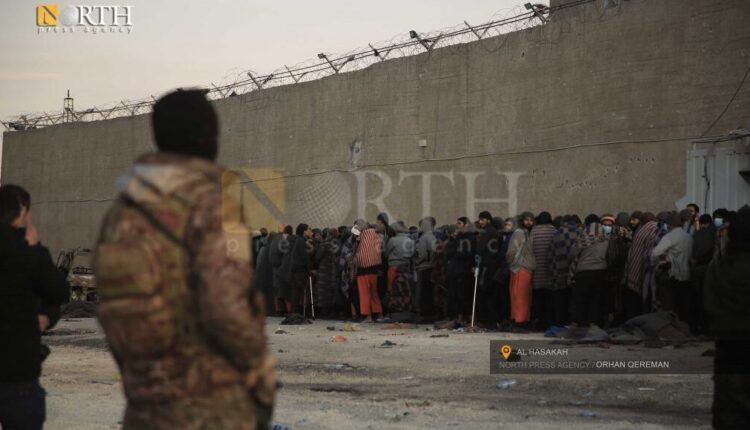
RAQQA, Syria (North Press) – Large swathes of the formerly self-proclaimed caliphate of the Islamic State Organization (ISIS) are ruled now by Syrian Democratic Forces (SDF), Syrian government forces, and Turkish-backed armed opposition factions, also known as Syrian National Army (SNA), in addition to the presence of regional powers (Turkey and Iran) and global ones (the US and Russia).
Observers believe that ISIS makes use of the military zone map and disputes among the three parties to consolidate its position in Syria.
ISIS has been used to operate on the margins and security vacuums. Actually, the group came into being emanating from al-Qaeda and announced produced itself as the Islamic State in Iraq and Syria (ISIS) after it was nurtured under the clock of al-Nusra Front (al-Qaeda’s Syrian military wing which is now known as Hayat Tahrir al-Sham-HTS) which it fought and expelled from Syria and Iraq early in 2014.
When the caliphate was announced, with the Syrian city of Raqqa being the capital, the group controlled large swathes of territories in both Syria and Iraq. However, early in 2017 the group began to recede under the blows of the Syrian Democratic Forces (SDF) with air support by the US-led Global Coalition to Defeat ISIS.
In March 2019 the group was announced defeated in its last pocket in the Deir ez-Zor village of Baghouz, east Syria, close to the border with Iraq.
However, the group took the Syrian Desert as a hideout from where it used to carry out attacks against the Syrian government forces adopting largely kick-and-run military technic.
The radical group adopted a new tactic after the Baghouz battle based on sleeper cells that do not have permanent or long presence at any spot.
The societal structure and ideological and nationalist discontent of people in areas formerly under control make it easy for the group contact sleeper cells that strike SDF fighters and Syrian government forces mostly Iranian-backed militias.
Last year, the SDF said it carried out 115 operations in cooperation with the Global Coalition against ISIS, 93 operations were against sleeper cells. It arrested 802 ISIS-related suspects and sleeper cell members.
However, from another perspective, since January 2022, the group has claimed responsibility for 156 operations in northeast Syria varying from murders and decapitations. To strike horror, decapitated heads were hanged.
ISIS sleeper cells are widely and largely publically active in east Deir ez-Zor; posts are hanged on walls, taxes are collected, and out-spoken voices are silenced and punishment is served.
Low-priced jihad
Observer on terrorist groups Omar Farouq told North Press “Although the organisation has failed from a propagandistic point of view, its polices of horrifying locals, exploiting security gaps, economic deterioration and social failure continue owing to the situation in Syria over the last ten years.”
Recently, the organization has installed camps for military armed training, raiding and storming a number of jails smuggling its militants. The attack on the al-Sina’a Prison in Hasakah is the best example, according to Farouq.
On January 22, 2022, ISIS attacked a main ISIS prison in the city of Hasakah home to leaders and militants of the radical group.
121 persons lost their lives in the attack; 77 persons were of the prison’s servicemen and staff, 40 SDF fighters and 4 civilians, according to SDF figures.
374 ISIS militants of the Hasakah’s prison attackers and inmates were killed in the clashes while 223 inmates remain unaccounted for.
There are nearly 12.000 foreign ISIS inmates of Syrian, Arabic, Asiatic and European backgrounds in some 10 prisons in separate areas of northeast Syria run by the Autonomous Administration of North and East Syria (AANES) in coordination with the Global Coalition to Defeat ISIS, according to the Syrian Observatory for Human Rights (SOHR).
Farouq told North Press targeting high-profile leaders of the organization is not a sound proof that the group has been exterminated or its presence and project in Syria and Iraq specifically and in the Arab region generally has been eliminated.
Since the organization was defeated territorially, the Coalition targeted a number its leaders such as Abu Bakr al-Baghdadi, Abdullah Qardash and Maher al-Agal in separate areas under Turkey’s rule in northern Syria.
Amid this reality, the group started to depend on an ideological project that aims to attract the youths via mediators to recruit them depending on social media, according to Farouq.
ISIS makes use of the societal structure to recruit cells and to target Iranians in the Syrian Desert and the countryside of Homs and Hama.
Claiming that ISIS has been rooted out from Syrian and Iraq and its resources were dried as an organization is “improper” as it still remains fortified and positions in the region and polarizes new admitted members, according to reports.
Farouq believes that ISIS operates as “guerrillas” inside Syria. It is low-priced jihad to inflict heavy losses on its opponents with the minimum available capabilities.
He added that the US intelligence and political reports signify that
